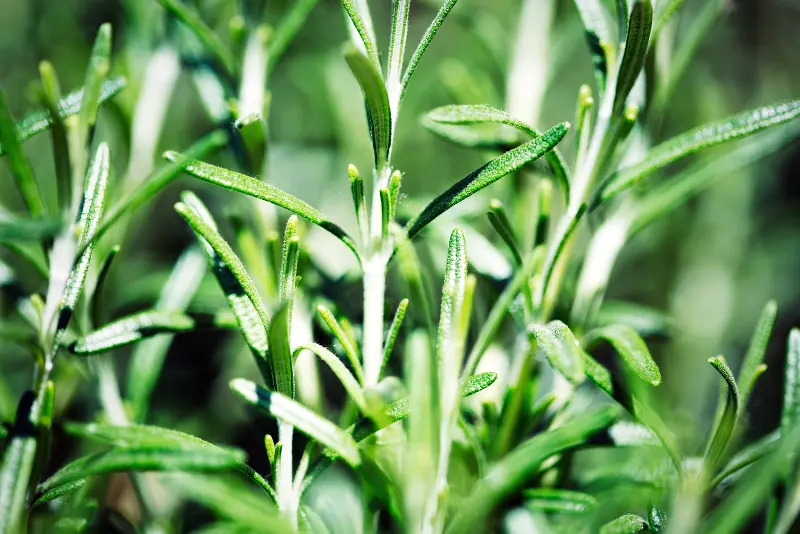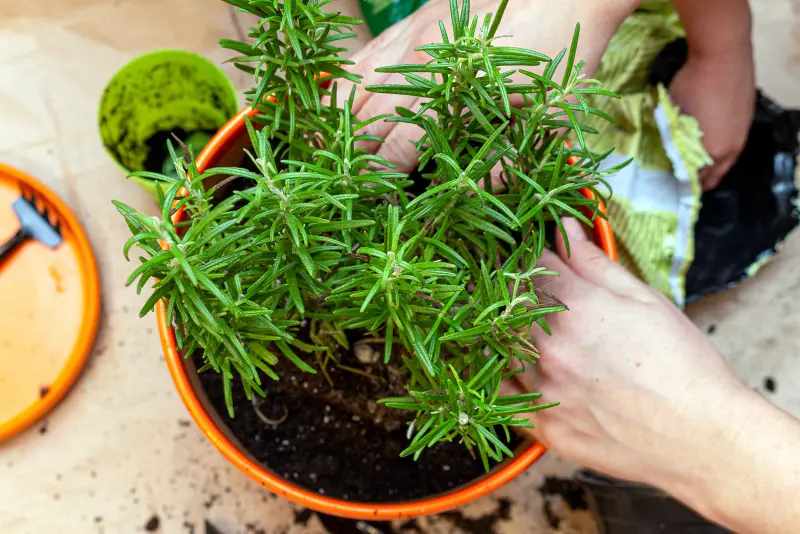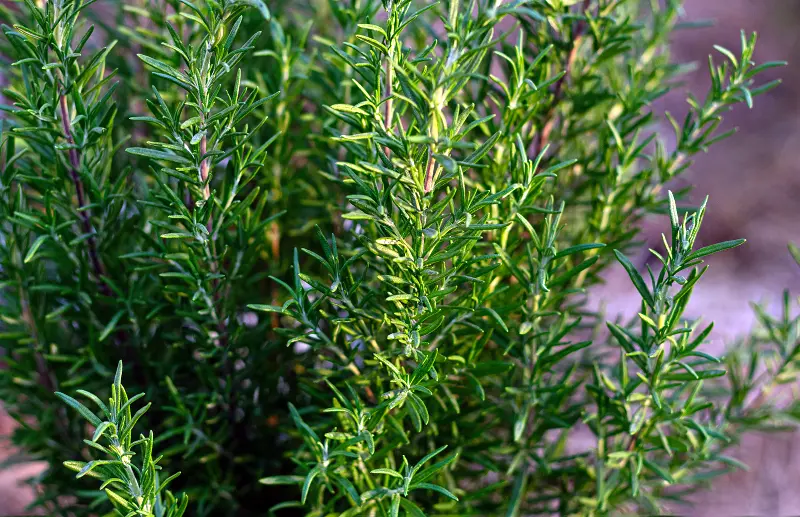If you’re interested in growing rosemary, you’re going to need to know how to take care of it. It’s not a difficult plant to care for, but it does have its own preferences. It’s very particular about how much sun it gets and what kind of soil it’s grown in. If you’re feeling overwhelmed, don’t worry. Rosemary can be grown even by beginners. My guide covers providing the best growing conditions for Rosemary. You will find why you should grow rosemary, the pros, and cons of growing rosemary in the garden vs in a pot, and the ideal rosemary plant growing conditions both inside and outside including where to plant, what soil to use, how often to water, and more. I also share when and how to harvest rosemary.
Let’s start!
THIS POST MAY CONTAIN COMPENSATED AND AFFILIATE LINKS. MORE INFORMATION IN OUR DISCLAIMER
Why Grow Rosemary?
People grow rosemary for a number of reasons, but the main reason is for cooking. It’s also useful in medicine and deterring pests. Some people simply like the way it looks.
Grow Rosemary for Cooking
Rosemary is one of the most popular herbs used in cooking. It is most popularly used in soups, sauces, and roasts. It’s great for these dishes because of its strong aroma and taste that can be overpowering in subtler dishes.
Any cook will tell you that purchasing fresh rosemary from the store can quickly become expensive. If you grow rosemary in your home or garden, you’ll always have fresh rosemary on hand to use in your cooking. You don’t even need to worry about your fresh rosemary going bad. It can be dried or frozen for later use.
Grow Rosemary for Appearances
Rosemary is a very beautiful plant and it will spruce up any garden. There is a rosemary plant for everyone because there are several different kinds. Some grow taller than they are wide, and others creep along the ground. The largest plants can grow up to 6-8 feet tall and wide. The smallest may only reach about 1 foot off the ground, but will creep along the ground for several feet.
Besides the volume they’ll add to your garden, they’re very pretty in color. The leaves are a dark green with a needle-like appearance. Some plants will sprout white, purple, or pink flowers in the springtime. Not only does it look very nice, but rosemary emits a very nice aroma as well.

Grow Rosemary for Medicine
This is a less-known use, but rosemary can be used to aid minor ailments.
Some people use rosemary to help with their anxiety, mild joint pain, stomach upset, and memory improvement. Sometimes, you can reap these benefits just by adding rosemary to your food. Others use it in incense or in essential oils.
Grow Rosemary for Pest Control
Although rosemary is not likely to kill off any existing pests, it is a good deterrent. As we said earlier, rosemary has a very strong scent. Although this scent is one of the reasons we love rosemary so much, it is unpleasant for many pests.
The scent of the rosemary plant will confuse and deter pests from entering your garden and going after your other plants.
Read more about using rosemary to repel pests here.
Gardening Chief Recommends.
Whether you’re buying seeds, seedlings, plants, propagation gear, or gardening tools here are our favorite suppliers.
Best for Seeds & Plants
- Seeds Now – Top seeds, root plants, and bulbs + daily deals – buy now!
- Amazon – seeds, plants, and growing kits – check options here
Best for Pots, Containers, Gardening Tools & Compost
- Amazon – superb selection of pots, containers, tools & compost – order here
Best for Growing Year Round – whatever weather
- Grow all year round with Click & Grow Hydroponics – Get your starter kit here
Growing Rosemary In A Pot Vs In Garden
Whether you choose to grow your rosemary in a pot or in the garden is entirely up to you. Neither option is really better, but they do have their own benefits as well as downsides.
Growing Potted Rosemary
Planting your rosemary in a pot is a good option if you want to have more control over your plant. That being said, it does tend to be more difficult to grow in a pot. Rosemary is very particular about what kind of soil it grows in and the amount of water it receives.
Rosemary doesn’t like a lot of water, so it needs to be in soil that drains very well. It can be difficult for people to find the right kind of soil for rosemary, and many gardeners end up creating their own concoction. Most people use a combination of regular potting soil and Perlite. Others may use cactus soil with Perlite.

One of the great things about growing rosemary in a pot is that you can easily take care of it over winter. Of course, you can always transplant your plant from the ground to a pot over winter, but that can be difficult and requires extra work. If your rosemary is already in a pot, you simply need to move it indoors.
Of course, some kinds of rosemary will be easier to grow in a pot than others. Rosemary that grows taller than it does wide will do best in a pot. However, some people like creeping rosemary in their pots too. The plants will spill over the edge of the pot, creating a waterfall-like effect.
Best Pots for Growing Rosemary
Growing Fresh Rosemary In The Garden
Growing your rosemary in a garden setting tends to be easier than growing it in a pot. Because of rosemary’s very specific needs, it can be challenging to take care of it in a pot. When growing in a garden, rosemary is more independent.
One advantage to growing your rosemary in a garden is that the plant won’t be limited in how large it can grow. It will have all the space it needs to spread out and grow. This is especially important since certain rosemary plants can grow up to 6-8 feet tall and wide.
Growing rosemary in your garden will also allow your garden to look prettier.
One of the greatest advantages to having rosemary in your garden is the effect it’ll have on pests. The strong odor that rosemary gives off attracts pollinators while repelling pests that will destroy your garden.
The only time growing rosemary in a garden setting is more difficult than in a pot is during winter. You’ll need to take certain precautions to ensure your rosemary survives the winter months.

Growing Rosemary Plants Outdoors
Of course, if you do plan to grow your rosemary outside, you’ll want to know how to take care of it. Fortunately, rosemary is a very easy plant to take care of, although it does have some very specific requirements.
Ideal Growing Conditions For Rosemary
Rosemary is a plant found natively in the Mediterranean regions of southern Europe and parts of Asia. Because of this, it’s used to warm temperatures, dry soil, and lots of sun.
Sun Requirements for Rosemary
The absolute most important thing when growing rosemary is to make sure it gets lots of sun. Rosemary cannot thrive without at least 6-8 of full sun a day. This means that it should not be in any shade. If your plant falls into some shade a few hours a day, that’s okay, but 6-8 hours of the day should be entirely full sun.
As we discussed earlier, it’s best to plant your rosemary on the eastern side of your house. The east is where the sun rises, so this will ensure that your plant gets plenty of sun throughout the entire day.
Read more about how much sun rosemary needs here.
Space Requirements for Rosemary
Rosemary plants can grow very large depending on the kind of rosemary plant you purchase. Certain rosemary can grow up to 6-8 feet tall or wide, taking up lots of space.
So, whether you’re buying multiple rosemary plants, or planning to plant your rosemary with other plant species, you’ll want to give them space. Rosemary should be planted at least 2-3 feet away from all other plants.
Best Soil Conditions For Rosemary
The second most important thing to know when growing rosemary is to know what kind of soil it needs. As we said, rosemary needs lots of sun and little water to thrive. It makes sense then that it would also need a well-draining soil to prevent it from becoming over watered.
As we said, most people use a combination of regular potting soil or cactus potting soil with a bit of Perlite.
Read more about the best soil for rosemary here.
When To Plant Rosemary
Technically, rosemary can be planted any time of the year, but it does best during the springtime. Spring is when rosemary begins to “wake up” and begin to grow. This is also when the temperatures are most moderate.
Buy Rosemary Seeds or Rosemary Plants here and get started now!
- These small rosemary plants will give you a great head start in growing Rosemary – get them now and start your rosemary journey today!
- Grow Rosemary year-round hydroponically – it’s easy wherever you live and whatever the weather. And it looks fabulous on the kitchen sill! – get a starter kit here.
- Grow Rosemary in Mason Jars – full seeds, kit and everything you need here.
Planting Rosemary in Spring
Spring is when you’ll see the most new growth in rosemary plants, and this is when they’re healthiest. This is also when you’ll begin to see flowers bloom on older, already established plants. Because rosemary automatically does best in spring, it makes sense then that it would also do best when planted in spring.
When you plant in spring, make sure to do it after the first frost. Although rosemary is cold tolerant, it doesn’t handle frost well. New and young plants are particularly susceptible to frost. If you’re not sure the last frost was really the last frost, it’s safer to wait a couple weeks.
Planting Rosemary in Winter
Winter is not a good time to plant rosemary because the temperatures are too cool and the plant can’t establish itself.
In areas where it’s really cold, rosemary will go dormant over winter, so they might not establish at all. If you try to plant rosemary over winter where it’s very cold, it’s likely that your plant will die.
Of course, if you’re growing your rosemary indoors, it can be planted at any time.
Planting Rosemary in Summer
Summer is a better time to plant than winter, but it’s still not idea. The weather is too hot, and it makes it too hard and stressful for the plant to try and establish itself.
Planting Rosemary in Fall
Fall is the next best time for rosemary to be planted. It’s not as good as spring, but the moderate temperatures of fall make it possible.
The issue with planting in fall is that it doesn’t give your plant much time to establish itself and grow. The plant will be preparing for winter. If the climate is cold enough, the plant will even go dormant and stop growing entirely during winter.
However, some people argue that fall is better than spring to plant specifically because it’s preparing for winter. During this time, rosemary becomes woodier and more sturdier. Some people argue that this increased sturdiness helps the roots to better take hold.
Either way, if you plan to plant in the fall, make sure to do it several weeks before the first frost. If you don’t give it time to establish itself before the first frost, the plant won’t survive.
Overall, most experts and gardeners agree that spring is the best time to plant rosemary. Read more here.
How To Plant Rosemary
The best time of year to plant rosemary is in the spring because that’s when the plant naturally grows. When planting a juvenile plant, you’ll want to plant it in the soil as deeply as it was planted in its original container.
If you’re planting from clippings (read how here), you’ll only want to cover the roots. If planting from seeds, you’ll only place the seeds about 1/4 inch deep in the soil.
How Often To Water Rosemary
Rosemary plants are very used to having little water and are even quite drought-tolerant. Because of this, you’ll want to be extra careful about not overwatering your plants. In fact, it’s better to underwater than overwater if you’re struggling to figure out what the right amount of water is.
In a pot, rosemary should only be watered when the soil has completely dried out. This gives your plant plenty of time to get the water it needs without being overwatered. It also prevents root rot.
The scenario is basically the same if your plant is growing outside as well. However, outside, rosemary can be watered while the soil is slightly damp.

Should I Use Spray Fertilizer On Rosemary?
Whether or not you use fertilizer is really going to depend on whether you’re planting inside or outside. Rosemary does do well with a bit of fertilizer, but you shouldn’t overdo it. It’s easy to over-fertilize your rosemary and kill it due to excess nutrients.
Rosemary that is planted outside generally doesn’t need any extra fertilization. The only time you should provide it with fertilizer is if it appears sick.
Inside, a balanced fertilizer is healthy for your rosemary plant as long as you use it in moderation.
Can Rosemary Survive Winter?
Rosemary can survive winter, depending on where you live. If you live in USDA hardiness zones 7 and under, your rosemary plants will need to be kept inside over winter. If you try to leave them outside, they will almost definitely die.
If you live in hardiness zones 8 and 9, your plants can survive outdoors, but you’ll want to prepare them. A good practice to keep is surrounding your rosemary shrub with bricks and layering the roots with an insulating mulch. You should also prune back the branches to about 6 inches.
Each of these practices will help your plant better survive the winter months. Read more here.
Best Rosemary Growing Conditions Indoors
Caring for rosemary in a pot indoors or outdoors is somewhat the same. In a pot, rosemary is going to need a lot more attention than if it’s being grown in a garden.
Above, we covered the basic care of potted rosemary. Here, we’ll cover a few things specific to potted plants kept indoors.
Sun Requirements for Growing Rosemary indoors
As we said, rosemary needs 6-8 hours of full sunlight a day. This can sometimes be difficult to achieve inside, especially if you don’t have enough window space. The way to solve this is by purchasing a “grow” light designed specifically for plants.
Temperature for Growing Rosemary indoors
Many people bring their rosemary plants inside over winter because it gets too cold outside. However, if you keep your plant inside year round, you also need to be cautious of the heat.
Rosemary grows best in temperatures of 65-80 degrees Fahrenheit. If your house goes above that in the summer, you’ll need to turn on your air conditioning.
When To Harvest Rosemary
Technically, because rosemary is perennial, you can harvest it at any time of the year. However, the best time to harvest is in the spring. Spring is when the plant will be doing most of its growing, and this is when it will be the healthiest.
How To Harvest Rosemary
Harvesting rosemary is quite easy. You’ll simply cut 4-6 inches of the stem tip off. As long as your plant is fully grown, you can take as many clippings as you like, and they’ll eventually regrow.
Final Rosemary Growing Tips
One thing we’d like to caution you on is to take extra care of your plant while it’s young. The first 6 months is when it’ll need the most care and attention.
Also, we know that most people purchase rosemary to use the herb. But, you don’t want to take any clippings from your rosemary for the first year. Taking clippings while the plant is still young can damage it and prevent it from growing properly in the future.
Final Words on the OPtimum Growing Conditions for Rosemary
You may be feeling overwhelmed right now. Rosemary is supposed to be an easy plant to care for, but there are all these guidelines for keeping it healthy. Don’t worry, it’s really not as hard as it seems. The two most important things to remember is to give rosemary plants lots of full sun and make sure it’s potted in well-draining soil. If you do those two things, your rosemary plant will do well. From there, you can work on learning how to make it thrive. Happy planting!
Want to learn more? Read about how to grow rosemary from cuttings here or in water here. You can also find all my rosemary guides here.
Gardening Chief is a participant in the Amazon Services LLC Associates Program, an affiliate advertising program designed to provide a means for sites to earn advertising fees by advertising and linking to amazon.com, amazon.co.uk, amazon.ca. Amazon and the Amazon logo are trademarks of Amazon.com, Inc. or its affiliates







